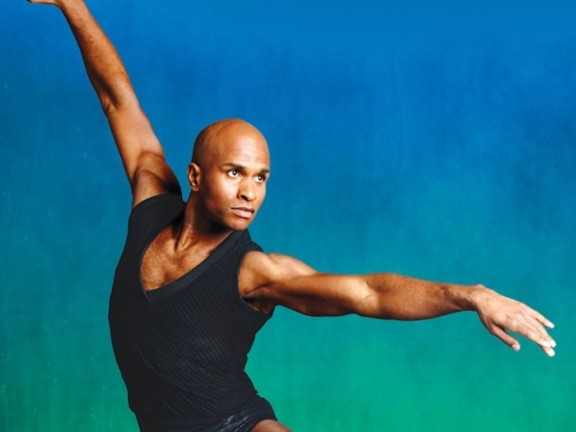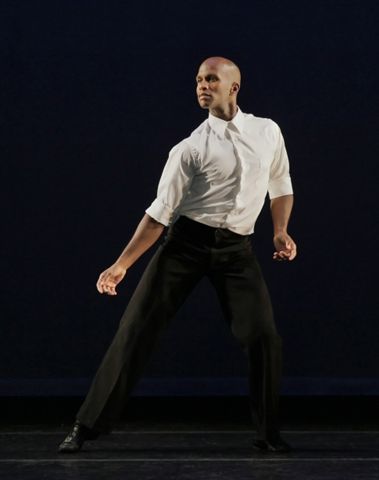Glenn Allen Sims of Alvin Ailey American Dance Theater


Over the last half-century, they’ve performed for 23 million people in 48 states and 71 countries.In 2008, Congress designated them as cultural ambassadors to the world.
And recently, they’ve introduced modern dance to legions of reality TV watchers with guest spots on Dancing With The Stars and So You Think You Can Dance.
Fifty-four years after legendary choreographer Alvin Ailey founded the company in New York City, the Alvin Ailey American Dance Theater remains one of the most iconic forces in dance.
On Friday, they’ll bring their celebrated routine back to the New Jersey Performing Arts Center in Newark, giving audiences a mix of classical, jazz and hip-hop numbers. And, of course, they’ll end the show as they always do: with their signature piece, “Revelations,” Ailey’s gospel-infused tribute to black history.
For dancer Glenn Allen Sims, returning to New Jersey’s largest city has extra meaning. The 15-year Ailey veteran grew up in the Garden State, living in Long Branch until enrolling at Julliard in 1994. He was asked to join the company three years later.
NJPAC’s audience will also witness a new chapter in Ailey’s history. It’s been less than a year since Robert Battle became the company’s third-ever artistic director.
“I’m sure people want to see how the company is going under the transition,” Sims says. “I would say the company is looking quite right and fresh. People have said the company looks its best in years.”
Jersey Arts’ Brent Johnson spoke with Sims about the strains of becoming a dancer, the health-care benefits of being an Ailey member and why NJPAC is an underrated gem of a venue.
Jersey Arts: If you dream of becoming a dancer, what do you need to do to make that happen?
Glenn Sims: To start off, you have to be determined, to be focused enough to want to be a dancer. If it’s a path you do take, it’s a lot of work. People think being a dancer is glamorous. But we’re the foot soldiers of the arts. As a dancer, monetarily you’re not paid as much as a musician or an opera singer. You have to be already cognizant of the fact that it’s not going to be a very lucrative lifestyle. Especially if you’re a concert dancer.
Secondly, make sure you have the right foundation — that being a dance school with great ballet training, with teachers who have a keen eye and take interest in their students.
JA: Where in New Jersey can someone go to learn?
GS: The school I trained at is the Academy of Dance Arts in Red Bank. It’s based off the Royal Academy of Dance syllabus. Dancers are trained through a syllabus — a set of exercises to help you build muscle, build stability. The director of the school, Jennifer church, made sure we had hours and hours of classes. I think I did nine hours of ballet classes a week. And they have modern dance and jazz classes. She set us up for professionalism.
The academy also had a company that put on productions at Count Basie Theater [in Red Bank] and a theater in Lakewood. Not only did we do something local, but we also had road trips. We had the experience of being outside our home and in our hotel rooms. It’s like a simulation of being a professional dancer. Right now with Alvin Ailey, I spent a lot of my time living in a hotel.
JA: How did you get involved with Ailey?
GS: I went to an audition to see where I would stand. I was going into my senior year [at Julliard]. Alvin Ailey has been a company that has tickled my fancy for a long time. It’s a repertory company that travels nationally and internationally. I have always been interested in seeing the world, seeing different cultures. It’s an organization that allows that.
Not only that, but I was more away that I didn’t just want to be a dancer and not have health insurance. Alvin Ailey provides health insurance and a retirement plan. I knew I needed to have some sort of protection — not just a part-time job.

JA: How proud are you to be involved with such a storied company?
GS: First of all, I’m still blessed that I have been able to be in this organization for 15 years. Being able to see the organization itself grow. To have helped countless individuals, young artists, young dancers make their way to being professional. Not only are we performing on Dancing With The Stars and So You Think You Can Dance — which is a great outlet for a company because our name is becoming familiarized to people who didn’t know us — but we’re also doing outreach. Ailey said dance came from the people, and it should always belong to the people.
JA: What’s the significance of Ailey returning to Newark?
GS: It’s our second home. Our first home is New York, but we’re coming to NJPAC for the 11th year. And for me being a Jersey boy, even though my family travels to New York to see me, a lot of my family makes an effort to see me at NJPAC. And it’s such a gorgeous place. A lot of people overlook it, because of the reputation of Newark. Even when I tell people in New York that I’ll be at NJPAC, they’re like, “Newark?” But I say it’s a really nice theater and the location is great. It’s only a half-hour drive from midtown New York. It’s another asset for people to see Ailey.
JA: Is it possible overestimate the exposure that is dance getting from TV shows like Dancing With The Stars and So You Think You Can Dance these days?
GS: Before, it was only a couple of shows. You could see dance only on Fame or something like that. Now, it’s something that has become a part of American culture. In Europe, they have had dance shows for years. It seems as thought American culture has finally caught up to another art form.
Finding dance can actually be entertaining. It shows dancers in another light. Not only are we disciplined, but we’re also athletes. Now, people are getting the inside scoop to the mental state of a dancer — what it means to become a professional dancer. It helps America understand that it’s a competitive world. You need to have a competitive spirit to make it to the top.
JA: How does Ailey relate to popular culture in modern dance?
GS: Our repertoire lends itself to that. In our repertoire, we have a piece called "Home" by Rennie Harris, who is a hip-hop coordinator. Alvin Ailey has always deal with issues and situations of the time. Being cultural ambassadors to the world — as we’re coined — it only behooves the company to keep abreast with what’s going on. You’ll get the classical aspects of dance — Paul Taylor or Alvin Ailey himself or Martha Graham — but you’ll also get something that’s fresh and new, dealing with issues of today, dealing with choreographers who are young with great ideas



